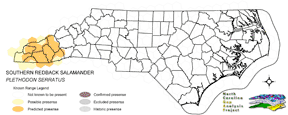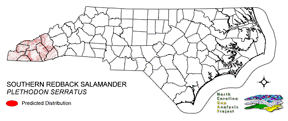
| Taxa: |
| Order: |
| Family: |
| Amphibia |
| Caudata |
| Plethodontidae |
| NatureServe Global Rank: |
| NatureServe State (NC) Rank: |
| G5 |
| S4 |
| Federal Status: |
| NC State Status: |
| --- |
| --- |


| Land Unit |
| US Fish & Wildlife Service |
| US Forest Service |
| US National Park Service |
| US Department of Defense |
| NC State Parks |
| NC University System |
| NC Wildlife Res. Com. |
| NC Forest Service |
| NC Div. of Coastal Mgmt. |
| Local Governments |
| Non-Governmental Org. |
| Other Public Lands |
| Private Lands |
| GAP Status 1-2 |
| All Protected Lands |
| Statewide |
| Hectares |
| 0.00 |
| 67,550.58 |
| 67.50 |
| 28,364.67 |
| 508.77 |
| 0.00 |
| 623.79 |
| 60.51 |
| 0.00 |
| 0.00 |
| 228.87 |
| 0.00 |
| 72,474.03 |
| 36,142.95 |
| 97,322.52 |
| 169,878.72 |
| Acres |
| 0.00 |
| 166,921.09 |
| 166.80 |
| 70,090.61 |
| 1,257.20 |
| 0.00 |
| 1,541.42 |
| 180.81 |
| 0.00 |
| 0.00 |
| 565.55 |
| 0.00 |
| 179,087.19 |
| 89,342.44 |
| 240,520.42 |
| 419,810.66 |
| % of Dist. on |
| Prot. Lands |
| 0.0 % |
| 69.4 % |
| 0.0 % |
| 29.1 % |
| 0.5 % |
| 0.0 % |
| 0.6 % |
| < 0.1 % |
| 0.0 % |
| 0.2 % |
| 0.2 % |
| 0.0 % |
| 0.0 % |
| 37.1 % |
| ----- |
| ----- |
| % of Dist. on |
| All Lands |
| 0.0 % |
| 39.8 % |
| < 0.1 % |
| 16.7 % |
| 0.3 % |
| 0.0 % |
| 0.4 % |
| < 0.1 % |
| 0.0 % |
| 0.0 % |
| 0.1 % |
| 0.0 % |
| 42.7 % |
| 21.3 % |
| ----- |
| ----- |
|
Found in the southwestern mountains of North Carolina (Martof et al. 1980). P. serratus occurs in the Blue Ridge Mountains south of the French Broad River (Redmond and Scott 1996). Like P. cinereus, P. serratus is found in terrestrial habits in upland forests (Redmond and Scott 1996). Found in mesic forests (Wilson 1995). Often most abundant in terrain features, such as coves, ravines, riparian zones and caves, that provide some insulation from high summer temperatures. It can also be found in abundance in mesic forests with plentiful dead and down wood, leaf litter and other debris on the forest floor. NATURE SERVE GLOBAL HABITAT COMMENTS: Found under rocks, rotten logs, and mosses in forested areas. In dry summer months it occurs in and near damp areas. Uncommonly found in twilight zone of caves. Eggs are laid in moss or rotten log, or under a rock or log. |
| Code | Name | Description | NC Natural Heritage Program Equivalent |
| 230 | Piedmont Mesic Forest | American Beech - Red Oak - White Oak Forests. | Mesic Mixed Hardwood |
| 384 | Piedmont/Mountain Mixed Bottomland Hardwood Forests | Includes temporarily to seasonally forests dominated by hardwood species. Hardwoods include sweetgum, red maple, sycamore which co-occur in a mosaic of bottomland and levee positions. Includes alluvial hardwood forests in the mountains. Hemlock and white pine may occur as inclusions, but are generally mapped separately. | Piedmont/Mountain Alluvial Forest, Piedmont/Mountain Levee Forest |
| 383 | Piedmont Mixed Successional Forest | Generally loblolly mixed with successional hardwoods. Sweetgum, tulip poplar and red maple are common co-dominants in these successional forests. | No equivalent |
| 36 | Successional Deciduous Forests | Regenerating deciduous trees with a shrub stature. Commonly dominated by sweetgum, tulip poplars and maples. | No equivalent |
| 517 | Hemlock Floodplain Forest | Alluvial forest with hemlock and/or white pine in mountains and western piedmont. Hydrology is generally temporarily to seasonally flooded. | Canada Hemlock Forest |
| 526 | Appalachian Cove Forest | Mixed Mesophytic forests of the mountains. Includes tuliptree, basswood, yellow buckeye and surgar maple. This class is mapped to include cove forests dominated or co-dominated by hemlock. | Rich Cove Forest, Acidic Cove Forest |
| 527 | Appalachian Hemlock | Upland hemlock forests of the moutains region. Vary from side slopes to steep slope positions. | Canada Hemlock Forest |
|
Taylor, C. L., R. F. Wilkinson, Jr., and C. L. Peterson. 1990. Reproductive patterns of five plethodontid salamanders from the Ouachita Mountains. Southwestern Naturalist 35:468-472.
Wilson, L. A. 1995. The Land Manager's Guide to the amphibians and reptiles of the South. Chapel Hill, NC: The Nature Conservancy. Redmond, W. H., and A. F. Scott. 1996. Atlas of amphibians in Tennessee. The Center for Field Biology, Austin Peay State University, Miscellaneous Publication Number 12. v + 94 pp. Johnson, T. R. 1977. The amphibians of Missouri. Univ. Kansas Mus. Nat. Hist., Pub. Ed. Ser. 6. ix + 134 pp. Behler, J. L., and F. W. King. 1979. The Audubon Society field guide to North American reptiles and amphibians. Alfred A. Knopf, New York. 719 pp. Martof, B. S., W. M. Palmer, J. R. Bailey, and J. R. Harrison, III. 1980. Amphibians and reptiles of the Carolinas and Virginia. University of North Carolina Press, Chapel Hill, North Carolina. 264 pp. Highton, R. 1986. PLETHODON SERRATUS. Cat. Am. Amph. Rep. 394.1-394.2. Camp, C. D. 1988. Aspects of the life history of the southern red-back salamander Plethodon serratus Grobman in the southeastern United States. Am. Midl. Nat. 119:93-100. |
For more information please contact them at:
NC-GAP Analysis Project
Dept. of Zoology, NCSU
Campus Box 7617
Raleigh, NC 27695-7617
(919) 513-2853
www.basic.ncsu.edu/ncgap